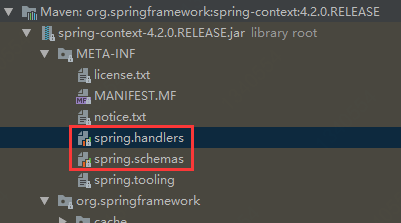Spring配置文件头及xsd文件版本浅析
一、Spring配置文件头
最初Spring配置文件的头部声明如下:
1 <?xml version="1.0" encoding="UTF-8"?> 2 <!DOCTYPE beans PUBLIC "-//SPRING//DTD BEAN 2.0//EN" 3 "http://www.springframework.org/dtd/spring-beans-2.0.dtd"> 4 <beans> 5 6 </beans>
说明:
1、第一行表示xml声明,任何格式良好的xml文档都必须第一行是声明。相当于告诉解析器这个是xml文档,你给我用xml解析器解析。
2、dtd声明,表示该xml里的元素和属性等需符合spring-beans-2.0.xsd这个文档类型定义标准。
3、DTD:文件的文件类型定义(Document Type Definition)可以看成一个或者多个 XML 文件的模板,在这里可以定义 XML 文件中的元素、元素的属性、元素的排列方式、元素包含的内容等等。
因为DTD的一些局限性,以及XML Schema对数据类型和命名空间的支持。XML Schema很快将 DTD 取而代之
被XML Schema 取代后的Spring 配置:
1 <?xml version="1.0" encoding="UTF-8"?> 2 <beans xmlns="http://www.springframework.org/schema/beans" 3 xmlns:xsi="http://www.w3.org/2001/XMLSchema-instance" 4 xmlns:context="http://www.springframework.org/schema/context" 5 xmlns:aop="http://www.springframework.org/schema/aop" 6 xsi:schemaLocation="http://www.springframework.org/schema/beans 7 http://www.springframework.org/schema/beans/spring-beans-4.2.xsd 8 http://www.springframework.org/schema/context 9 http://www.springframework.org/schema/context/spring-context-4.2.xsd 10 http://www.springframework.org/schema/aop 11 http://www.springframework.org/schema/aop/spring-aop-4.2.xsd"> 12 13 </beans>
XML Schema命名空间作用:
1、避免命名冲突,与Java中的package类似
2、将不同作用的标签分门别类(像Spring中的tx命名空间针对事务类的标签,context命名空间针对组件的标签)
代码解释:
1、xmlns="http://www.springframework.org/schema/beans"
声明xml文件默认的命名空间,表示未使用其他命名空间的所有标签的默认命名空间。
2、xmlns:xsi="http://www.w3.org/2001/XMLSchema-instance"
声明XML Schema 实例,声明后就可以使用 schemaLocation 属性了
3、xmlns:aop="http://www.springframework.org/schema/aop"
声明前缀为aop的命名空间,后面的URL用于标示命名空间的地址不会被解析器用于查找信息。其惟一的作用是赋予命名空间一个惟一的名称。当命名空间被定义在元素的开始标签中时,所有带有相同前缀的子元素都会与同一个命名空间相关联。
4、xsi:schemaLocation=" http://www.springframework.org/schema/beans http://www.springframework.org/schema/beans/spring-beans-4.2.xsd
这个从命名可以看出个大概,指定Schema的位置这个属性必须结合命名空间使用。这个属性有两个值,第一个值表示需要使用的命名空间。第二个值表示供命名空间使用的 XML schema 的位置
所以我们需要什么样的标签的时候,就引入什么样的命名空间和Schema 定义就可以。
二、XSD有没有版本号的区别
通常情况下,namespace对应的URI是一个存放XSD的地址
1 <?xml version="1.0" encoding="UTF-8"?> 2 <beans xmlns="http://www.springframework.org/schema/beans" 3 xmlns:xsi="http://www.w3.org/2001/XMLSchema-instance" 4 xmlns:context="http://www.springframework.org/schema/context" 5 xmlns:aop="http://www.springframework.org/schema/aop" 6 xsi:schemaLocation="http://www.springframework.org/schema/beans 7 http://www.springframework.org/schema/beans/spring-beans.xsd 8 http://www.springframework.org/schema/context 9 http://www.springframework.org/schema/context/spring-context.xsd 10 http://www.springframework.org/schema/aop 11 http://www.springframework.org/schema/aop/spring-aop.xsd"> 12 13 </beans>
schemaLocation提供了一个xml namespace到对应的XSD文件的一个映射,所以我们可以看到,在xsi:schemaLocation后面配置的字符串都是成对的,前面的是namespace的URI,后面是xsd文件的URI。
Spring默认在启动时是要加载XSD文件来验证xml文件的,所以如果有的时候断网了,或者一些开源软件切换域名,那么就很容易碰到应用启动不了。曾经Oracle收购Sun公司时,遇到过这个情况。为了防止这种情况,Spring提供了一种机制,默认从本地加载XSD文件。打开spring-context-4.2.0.RELEASE.jar,可以看到里面有两个特别的文件:

spring.handlers

spring.schemas

再打开jar包里的org/springframework/context/config/ 目录,可以看到下面有
spring-context-2.5.xsd
spring-context-3.0.xsd
spring-context-3.1.xsd
spring-context-3.2.xsd
spring-context-4.0.xsd
spring-context-4.1.xsd
spring-context-4.2.xsd

很明显,可以想到Spring是把XSD文件放到本地了,再在spring.schemas里做了一个映射,优先从本地里加载XSD文件。
并且Spring很贴心,把旧版本的XSD文件也全放了。这样可以防止升级了Spring版本,而配置文件里用的还是旧版本的XSD文件,然后断网了,应用启动不了。
我们还可以看到,在没有配置版本号时,用的就是当前版本的XSD文件:

结论:不要在Spring的配置文件中配置XSD的版本号,因为没配置版本号时,默认取当前jar里的XSD文件,减少了各种风险。而且这样约定大于配置的方式很优雅。
posted on 2019-08-14 20:27 Yorick-2016 阅读(3668) 评论(1) 编辑 收藏 举报





